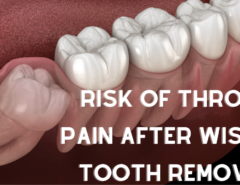Wisdom teeth are the third set of molars located in the back of your mouth. They typically begin to emerge between the ages of 17 and 25, although there’s no way to know exactly when they will start growing. Many people never have problems with their wisdom teeth, but if you have had them removed, you may be at risk for an infection in the surrounding tissue, which can be painful and require antibiotics to cure. In some cases infection After Wisdom Teeth Removal, it might even lead to more invasive treatments like surgery or taking out all four wisdom teeth at once instead of one by one.
What is a wisdom tooth extraction?
A wisdom tooth extraction is a surgical procedure to remove one or more wisdom teeth the four permanent teeth located at the back corners of your mouth on top and bottom.
Wisdom tooth extractions are usually performed by an oral surgeon under local anesthesia, sedation, or general anesthesia.
If you have a lot of crowding in your mouth, your dentist or oral surgeon may recommend removing one or more of your wisdom teeth to prevent future problems.
Typical recovery process
Most people recover from wisdom teeth removal without any issues. However, it’s not uncommon for people to experience some complications, like an infection. Here’s what you need to know about tooth infections after wisdom teeth removal, and how to tell if you have one.
Signs and symptoms of an infection: The most common symptom of an infected tooth is pain. You might also notice that your gums are swollen or red, and that you have a fever.
It’s important to be aware of these signs so that you can quickly seek treatment, since they’re an indication that the infection could spread to other parts of the body.
What are the signs of an infection?
The most common sign of an infection is pain. Other signs include:
- Swelling around the affected tooth or area ;
- Swollen lymph nodes in your neck, jaw, and face;
- Tenderness when chewing on that side of your mouth;
- Redness in that area.
Why do people get tooth infections?
After having your wisdom teeth removed, it’s not uncommon to develop an infection in the gums. This can happen because the area is difficult to keep clean, and food particles can become trapped in the gum line. If bacteria are present, they can cause an infection. Symptoms of a tooth infection include pain, swelling, redness, and pus. If you think you might have an infection, it’s important to see a dentist right away so that it can be treated.
Are all cases of tooth infection treated in the same way?
No, not all cases of tooth infection are treated in the same way. Depending on the severity of the infection, your dentist may recommend a different course of treatment. For example, a mild infection may be treated with antibiotics, while a more severe infection may require surgery.
What can I do to prevent an infection from my surgery?
- First, it is important to practice good oral hygiene. This means brushing your teeth twice a day, flossing daily, and using mouthwash.
- It is also important to eat healthy foods and avoid sugary drinks.
- If you do develop an infection, it is important to see your dentist or oral surgeon right away so that they can prescribe antibiotics.
- Additionally, you should avoid smoking and drinking alcohol while you are healing. These will only delay the process of getting better and may cause more harm than good.
- Finally, it is important to rest your jaw as much as possible for the first few days following surgery by avoiding any heavy lifting or strenuous activities.
- Your body will heal faster with proper care!
Also Read: Sore Throat After Wisdom Teeth Removal?
FAQs | Tooth infection After Wisdom Teeth Removal
How common is infection after wisdom teeth removal?
Infection after wisdom teeth removal is actually quite common. In fact, up to 25% of people who have their wisdom teeth removed will develop an infection in the days or weeks following the procedure. Up to 30% of these infections are classified as severe and can be life-threatening.
How do you know if you have an infection after wisdom teeth removal?
If you have any pain or swelling around your gums, jaw, or face, it could be a sign of an infection. Other symptoms include fever, trouble opening your mouth, and bad breath.
How does a dentist treat dry socket?
A dentist will usually treat a dry socket by cleaning it out and then packing it with gauze. They may also prescribe antibiotics to help fight the infection.
Do stitches prevent dry socket?
Dry socket is a common complication after wisdom teeth removal. It occurs when the blood clot that forms in the socket after surgery dissolves or is dislodged. Symptoms include severe pain, erythema, and bad breath. A person should see their dentist as soon as possible if they notice any of these symptoms so they can be treated quickly.
Is it normal to still have pain 7 days after wisdom tooth extraction?
Wisdom tooth extraction is a surgical procedure that comes with a certain amount of discomfort and pain. It’s normal to experience some level of pain and soreness for the first few days following surgery. However, if you’re still experiencing pain 7 days after your procedure, there may be something else going on. It’s possible that you could have developed an infection at the extraction site.
How do I know if my extraction site is infected?
If you’re experiencing pain, swelling, or redness around the extraction site, you may have an infection. Other symptoms include fever, difficulty opening your mouth, and bad breath. Seek medical attention immediately if you notice any of these warning signs.
Also Read:- How to Sleep After Wisdom Teeth Removal?
How do I know if my wisdom tooth extraction is healing properly?
Wisdom tooth extractions are a common dental procedure, but that doesn’t mean they’re without risk. One of the potential complications is an infection at the site of the extraction. If you experience any unusual symptoms, like fever or pus around the wound, swelling in your face or neck, or redness in your gums where your tooth was removed it could be due to an infection. If these symptoms persist for more than two days following your surgery you should see a dentist immediately.
What are the symptoms of a jaw bone infection?
The first way is by looking at the surgical site. If it is red, swollen, or has pus coming from it, then there is a chance that you have an infection. The second way is by feeling your lymph nodes. They should be firm and located in front of your ears. If they are painful, enlarged, or feel like they’re draining pus, then there’s a good chance that you may have an infection.
Can gauze pull out blood clot?
Gauze is not meant to remove blood clots. If you try to remove a clot with gauze, you may end up damaging the clot and causing more bleeding.
Will infection go away after tooth extraction?
When the tooth is removed, an infection can take several weeks to manifest. It starts when bacteria enter the empty space where the tooth was. The infection begins once the bacteria have made their way into the bloodstream.




